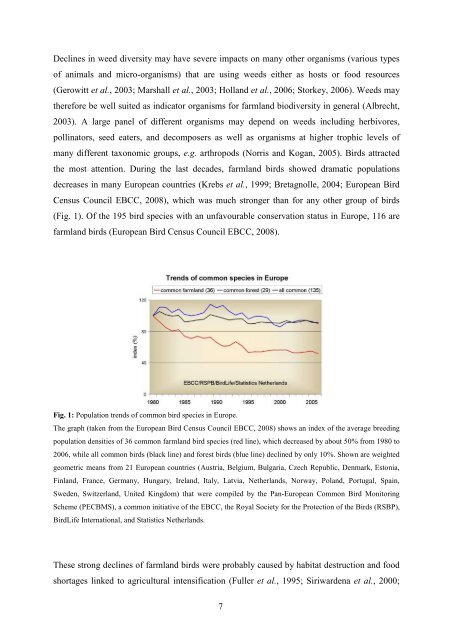Diversifying crop rotations with temporary grasslands - Université de ...
Diversifying crop rotations with temporary grasslands - Université de ...
Diversifying crop rotations with temporary grasslands - Université de ...
You also want an ePaper? Increase the reach of your titles
YUMPU automatically turns print PDFs into web optimized ePapers that Google loves.
Declines in weed diversity may have severe impacts on many other organisms (various types<br />
of animals and micro-organisms) that are using weeds either as hosts or food resources<br />
(Gerowitt et al., 2003; Marshall et al., 2003; Holland et al., 2006; Storkey, 2006). Weeds may<br />
therefore be well suited as indicator organisms for farmland biodiversity in general (Albrecht,<br />
2003). A large panel of different organisms may <strong>de</strong>pend on weeds including herbivores,<br />
pollinators, seed eaters, and <strong>de</strong>composers as well as organisms at higher trophic levels of<br />
many different taxonomic groups, e.g. arthropods (Norris and Kogan, 2005). Birds attracted<br />
the most attention. During the last <strong>de</strong>ca<strong>de</strong>s, farmland birds showed dramatic populations<br />
<strong>de</strong>creases in many European countries (Krebs et al., 1999; Bretagnolle, 2004; European Bird<br />
Census Council EBCC, 2008), which was much stronger than for any other group of birds<br />
(Fig. 1). Of the 195 bird species <strong>with</strong> an unfavourable conservation status in Europe, 116 are<br />
farmland birds (European Bird Census Council EBCC, 2008).<br />
Fig. 1: Population trends of common bird species in Europe.<br />
The graph (taken from the European Bird Census Council EBCC, 2008) shows an in<strong>de</strong>x of the average breeding<br />
population <strong>de</strong>nsities of 36 common farmland bird species (red line), which <strong>de</strong>creased by about 50% from 1980 to<br />
2006, while all common birds (black line) and forest birds (blue line) <strong>de</strong>clined by only 10%. Shown are weighted<br />
geometric means from 21 European countries (Austria, Belgium, Bulgaria, Czech Republic, Denmark, Estonia,<br />
Finland, France, Germany, Hungary, Ireland, Italy, Latvia, Netherlands, Norway, Poland, Portugal, Spain,<br />
Swe<strong>de</strong>n, Switzerland, United Kingdom) that were compiled by the Pan-European Common Bird Monitoring<br />
Scheme (PECBMS), a common initiative of the EBCC, the Royal Society for the Protection of the Birds (RSBP),<br />
BirdLife International, and Statistics Netherlands.<br />
These strong <strong>de</strong>clines of farmland birds were probably caused by habitat <strong>de</strong>struction and food<br />
shortages linked to agricultural intensification (Fuller et al., 1995; Siriwar<strong>de</strong>na et al., 2000;<br />
7

















